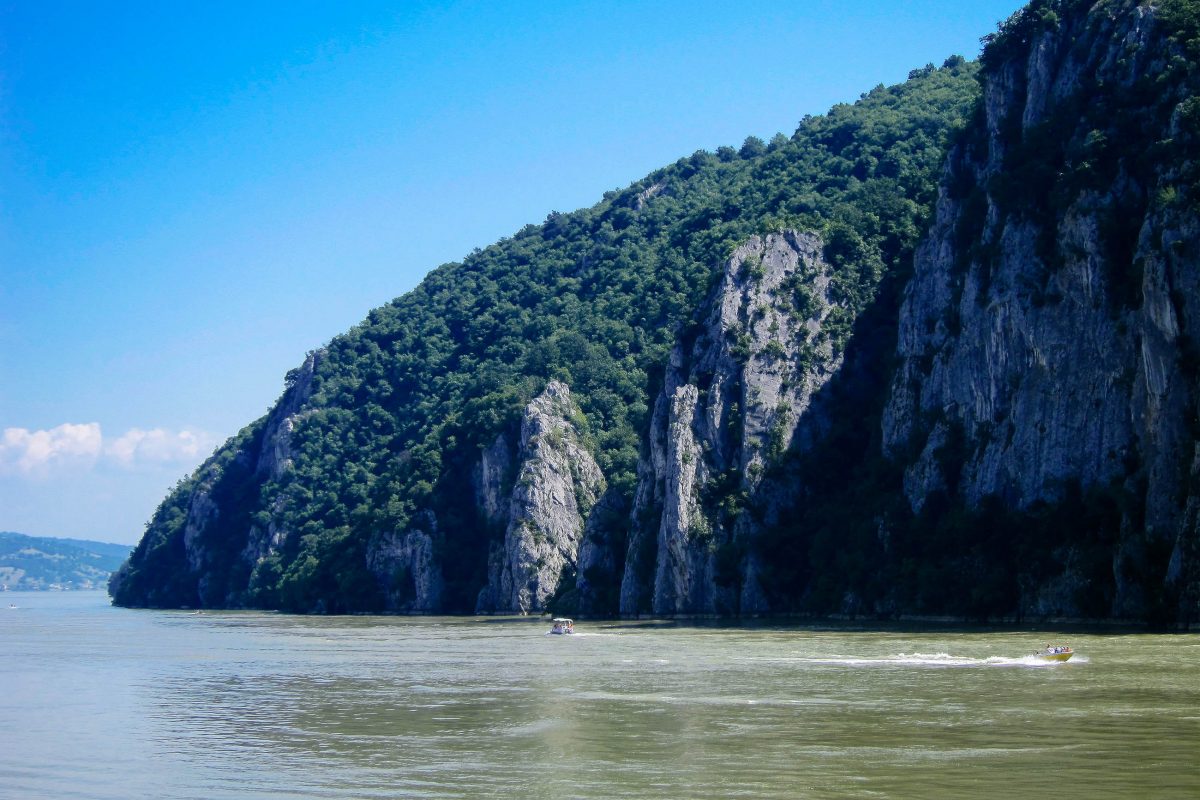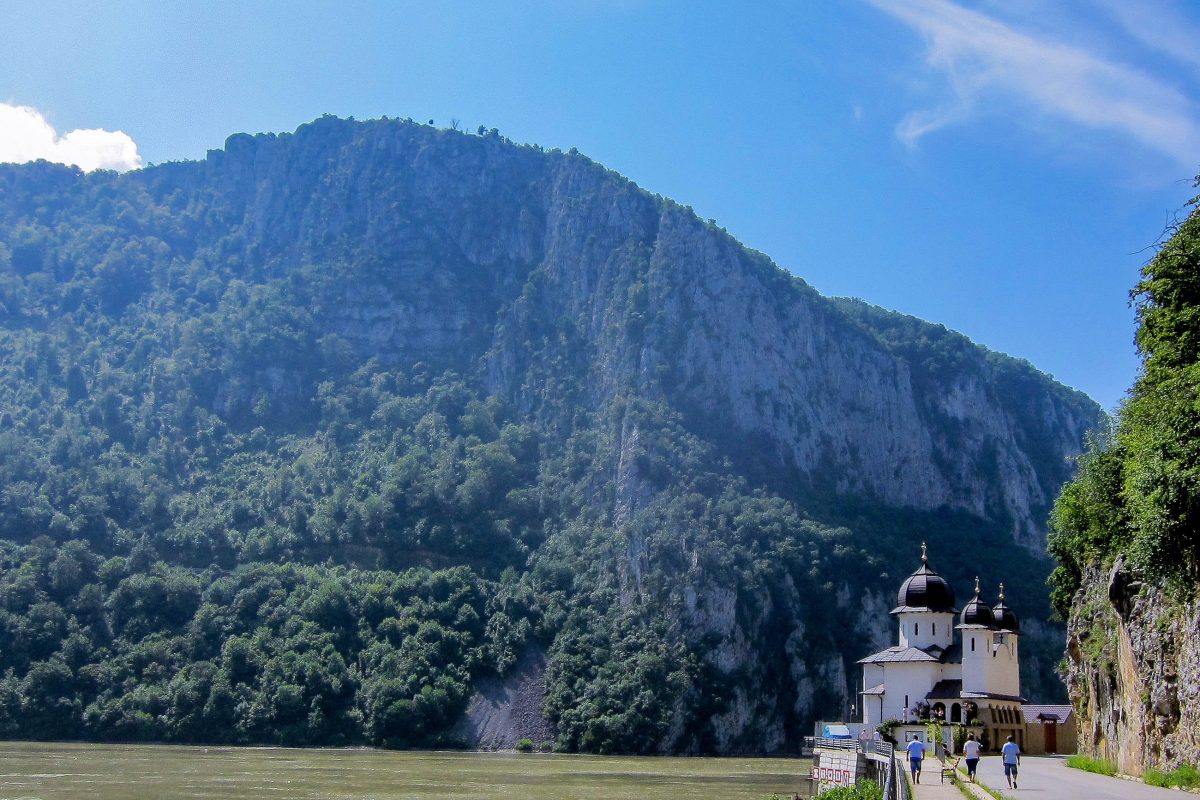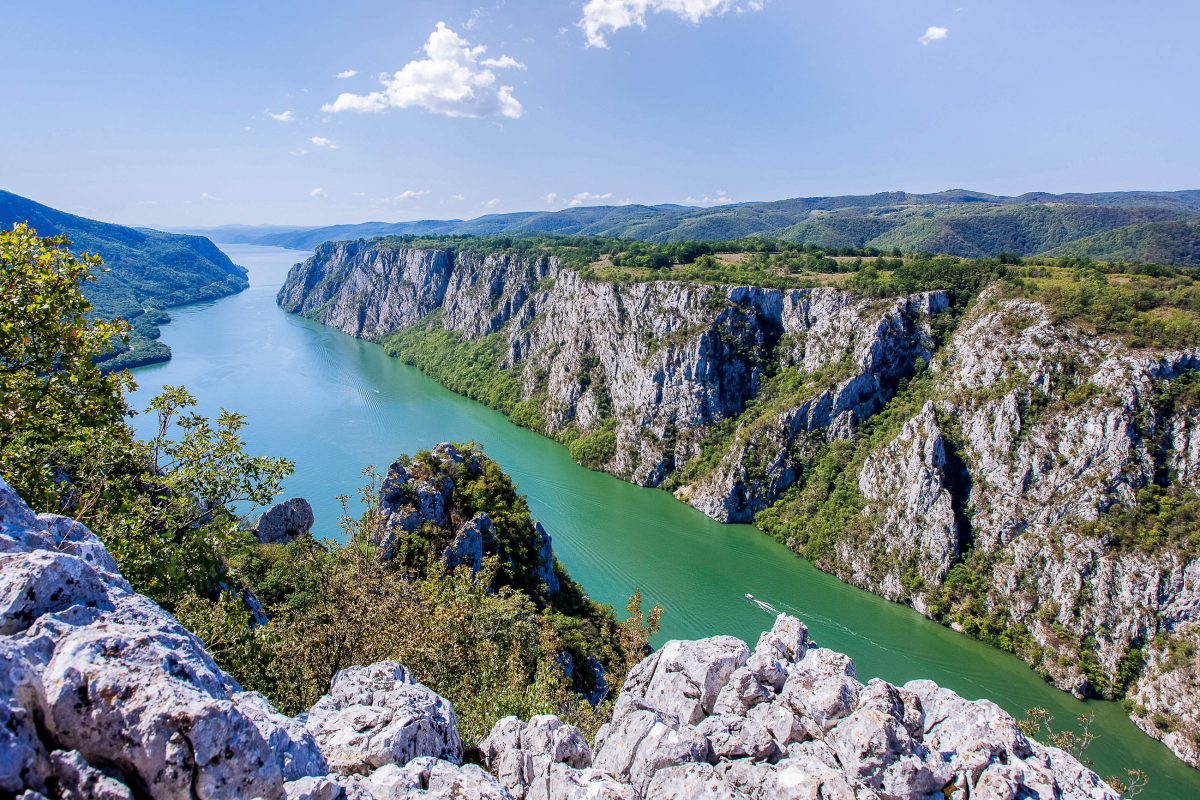Der Naturpark Eisernes Tor an der serbischen Grenze in Rumänien beherbergt zwischen spektakulären Klippen des Donaukessels jahrtausendealte Vermächtnisse und gewaltige Bauten.
Im Südwesten Rumäniens an der Donau und damit der Grenze zum Nationalpark Đerdap in Serbien liegt der idyllische Naturpark Eisernes Tor (Parc Natural Porțile de Fier). Zwischen spektakulären Talkesseln und den schroffen Gipfeln der Karpaten verbergen sich neben einer vielfältigen Flora und Fauna auch römische Ruinen, schmucke Klöster und Höhlen mit fossilen Überresten und historischer Bedeutung. Die fantastische Landschaft zählt zu unseren Top 10 Sehenswürdigkeiten von Rumänien.
Inhaltsverzeichnis
BILDER: Naturpark Eisernes Tor
Fotogalerie: Naturpark Eisernes Tor
Mit dem Schiff durch den Naturpark Eisernes Tor
Am besten lässt sich die Schönheit des Donaukessels im Naturpark mit dem Schiff erkunden. Schiffstouren auf der Donau starten am besten in der Ortschaft Orșova.
Diese liegt am Rande des Staudamms Porțile de Fier und wurde 1970 umgesiedelt. Das ursprüngliche Orșova versank in den Fluten des Stausees. Sehenswert sind heute die gewaltige römisch-katholische Kirche, die als architektonisches Monument Europas gilt und die denkmalgeschützte St. Nicolai-Kirche.
Vor der Entschärfung der Donau durch den Staudamm galten die Kilometer vor dem Eisernen Tor als gefährlichster Flussabschnitt der Donau und durfte nur mit Unterstützung durch Lotsen befahren werden.
Spektakuläre Steilwände an der Donau
Trotz aller Gefahr beginnt hier die schönste Strecke des Donaukessels. Die Donau ist hier nur 200 Meter breit und gewaltige 80 Meter tief. Die bis zu 300 Meter hohen Steilwände scheinen teilweise regelrecht über dem Wasser zu schweben und bieten fantastische Fotomotive.

Tipp: Bei der Verwaltung des Nationalparks können Bootsfahrten auf Anfrage gebucht werden. Auch einige Pensionen in Orșova unternehmen mit ihren Gästen Touren mit Privatbooten. Die Schönheit des Donaukessels kann aber auch von der Nationalstraße DN57 aus genossen werden.
Jahrtausendealte Vermächtnisse einstiger Herrscher
Von Orșova bis zum Eisernen Tor besticht die Flusslandschaft nicht nur durch ihr attraktives Panorama, sondern auch durch historische Vermächtnisse aus der Stein-, Bronze- und Eisenzeit, sowie des Römischen Reiches.
Tabula Traiana

Die erste Attraktion, die auf einer Schifffahrt ab Orșova sichtbar wird, ist die so genannte Tabula Traiana, die „Tafel des Trajan“. Diese Inschrift wurde zum Andenken an den Bau des auch „Trajan-Straße“ genannten Straßenabschnitts in den Berg gemeißelt. Nach dem Bau des Staudamms wurde sie nach oben versetzt.
Statue des Dakerkönigs Decebalus

Besonders eindrucksvoll präsentiert sich die Statue des Dakerkönigs Decebalus bei der Mündung der Mraconia am serbischen Donauufer. Den gewaltigen steinernen Kopf ließ der rumänische Geschäftsmann Iosif Drăgan direkt in den Berg meißeln. Der 2005 nach zehnjähriger Arbeit fertiggestellte Koloss ist mit 40 Metern Höhe und 25 Metern Breite die größte Felsskulptur Europas.
Trajansbrücke
15km vor dem Eisernen Tor sind auch noch die Überreste der ehemals eindrucksvollen Trajansbrücke zu sehen, die bereits im ersten Jahrhundert nach Christus über die Donau führte und das heutige Serbien mit Rumänien verband. Über 1000 Jahre lang war die von Apollodor von Damaskus entworfene Brücke die längste der Welt.
Festungen und Klöster im Donaukessel

Als bedeutender Verkehrsweg wurden die beiden Donauufer bereits früh mit Befestigungsanlagen und Gotteshäusern versehen. Von vielen historischen Bauten sind heute nur noch Ruinen übrig, die vielfach durch den Bau des Staudamms geflutet wurden. Einige davon wurden allerdings wieder aufgebaut, wie zum Beispiel das schmucke Kloster Mraconia.
Es liegt rund 100 Meter nach der Mraconia-Mündung und der Decebalus-Statue, wie es malerischer kaum sein könnte. Der heutige Bau stammt aus dem Jahr 2000, nachdem das originale Kloster ebenfalls durch den Staudamm geflutet wurde. Ebenfalls markant sind die steinernen Türme der Festungsruine Tri Kule.
Eisernes Tor – Talenge und Kraftwerk

Das Eiserne Tor gilt als einer der beeindruckendsten Taldurchbrüche in Europa. Mitten in den Karpaten, zwischen Serbien und Rumänien verengt sich der Lauf der Donau auf lediglich 150 Meter. Mit dem Kraftwerk Eisernes Tor 1 liegt hier das stärkste Laufkraftwerk an der gesamten Donau.
Das rund 130km lange Tal ist in Serbien als Djerdap Gorge und in Rumänien als Cazanele Dunarii (Donaukessel) bekannt und beeindruckt mit seinen bis zu 300 Meter hohen Steilwänden. Unterteilt wird der Donaukessel in den kleinen (Cazanele Mici) vom Ogradena-Tal bis Dubova und in den großen Kessel (Cazanele Mari), der von Dubova bis zum Viadukt Graniceri führt.
Grenzübergreifender Naturschutz am Eisernen Tor
Der gut 115.000 Hektar fassende Naturpark Eisernes Tor wurde im Jahr 2000 gegründet ist seit 2011 von internationaler Bedeutung nach der Ramsar-Konvention. Auch das gegenüberliegende Donauufer in Serbien steht als Nationalpark Đerdap unter Naturschutz.
Beide Naturschutzgebiete sollen in Zukunft ein grenzüberschreitendes Biosphärenreservat bilden, um die einzigartige Flora und Fauna im serbisch-rumänischen Donauraum zu schützen. Dabei handelt es sich um über 1.000 Pflanzenarten und seltene oder bedrohte Tierarten wie Braunbären, Wölfen, Goldschakalen, Luchsen, Wildschweinen, Schwarzstörchen und mehrere Eulenarten.





